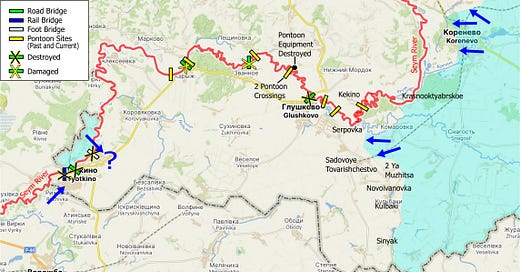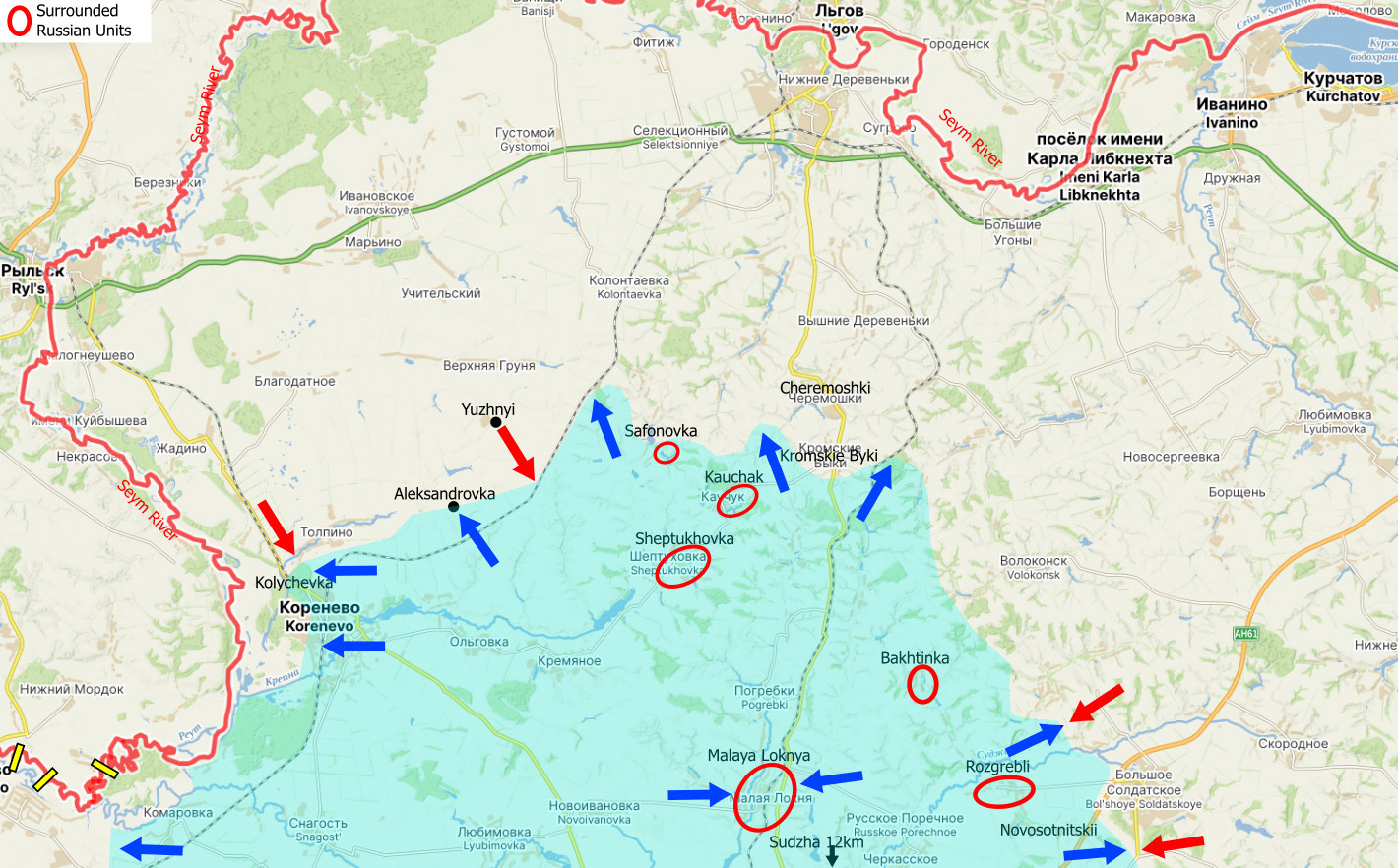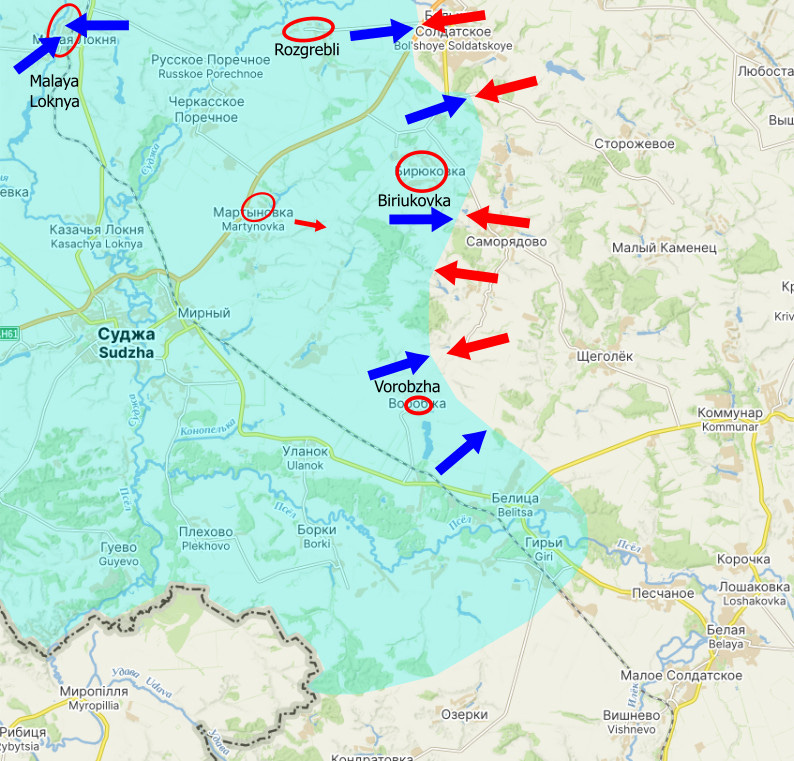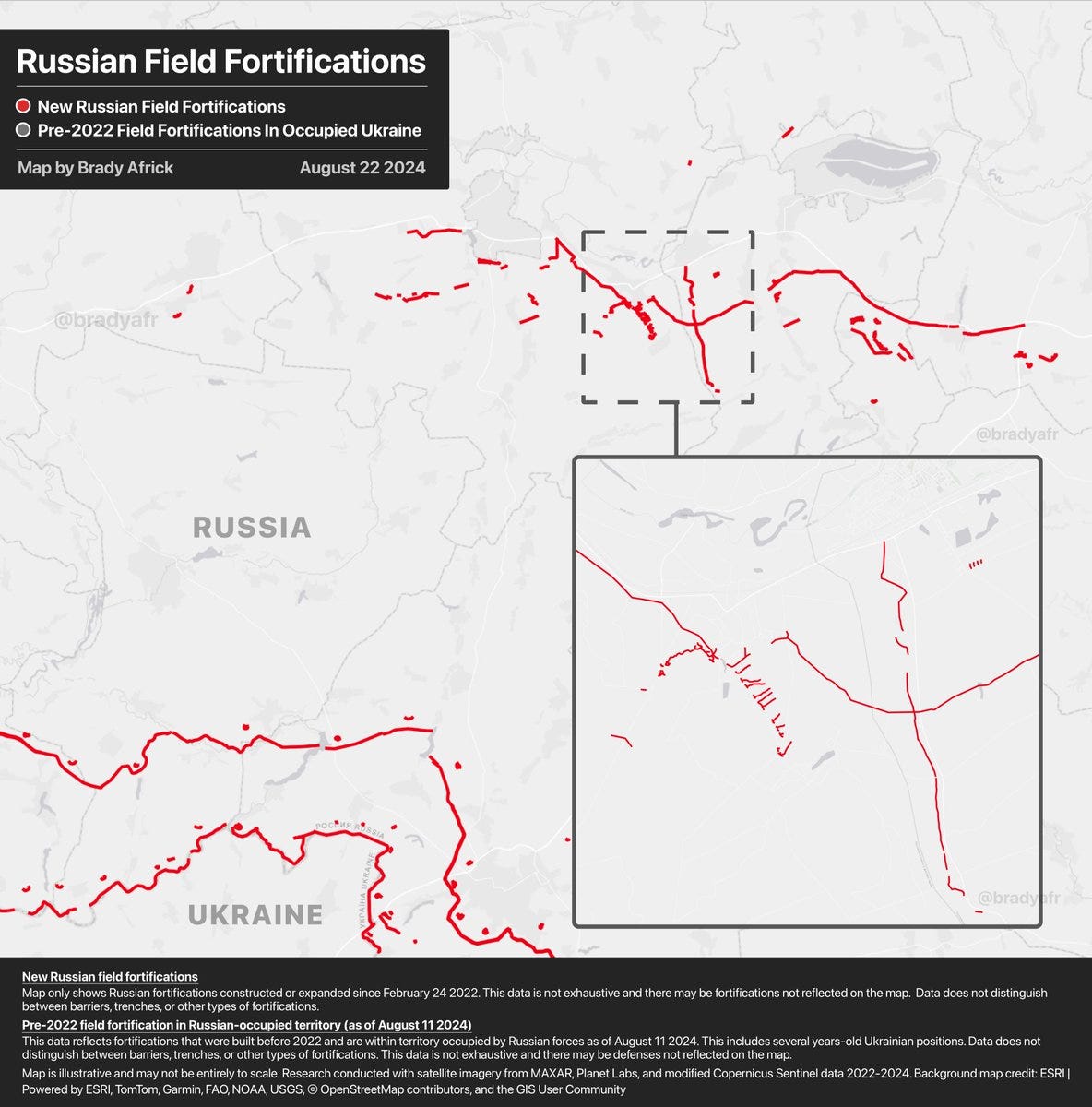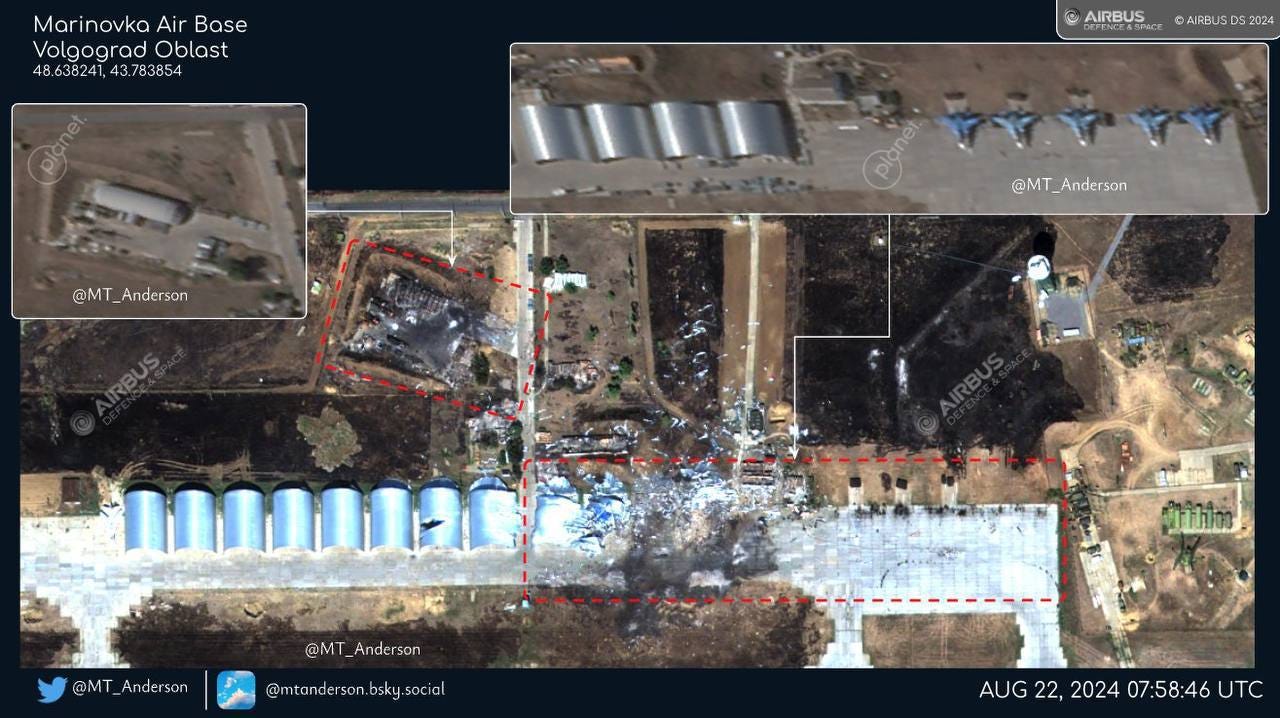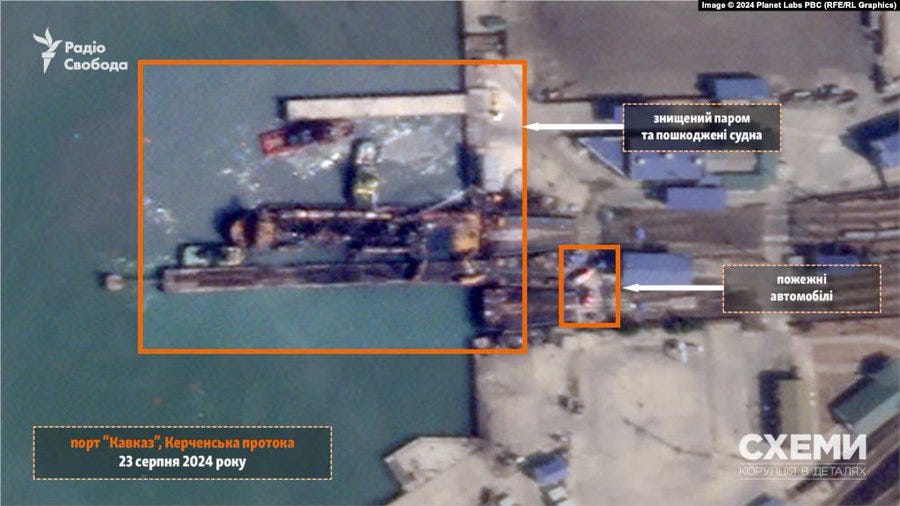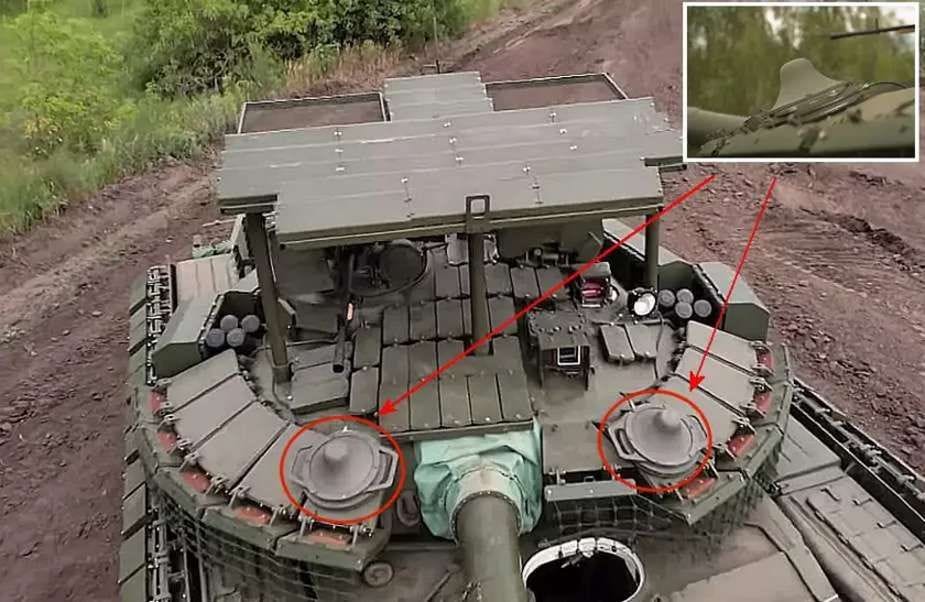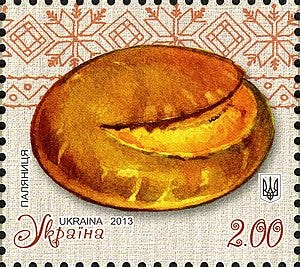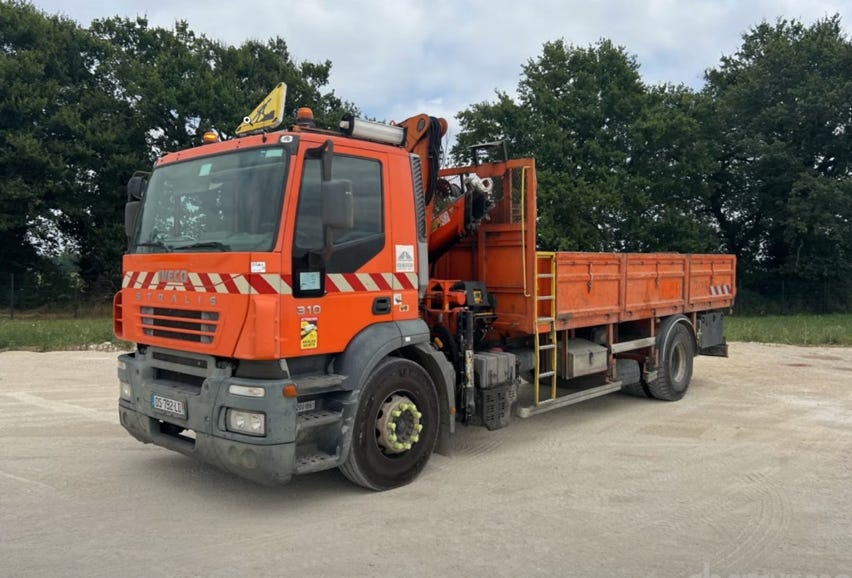Bryansk
The strength of Russian attacks is based on the endless waves of meat assaults that wear down Ukrainian defenses over time. In order to sustain the wave attacks they need to concentrate a lot of people. While Russia has a lot of people, their supply of manpower has limits and they decided to concentrate their forces in Ukraine while thinly defending their international borders with Ukraine.
Incursions by Free Russian forces and other non-Ukrainian forces over the months showed how thinly defended the international border was, but these units were too small to be able to sustain operations in Russia for long periods of time. Russia could tolerate these incursions since they were forced to withdraw after a short period of time. The border raids did provide Ukraine with more information on Russian defenses and response times, though.
The offensive in Kursk was a different matter. Not only has the invasion embarrassed Russia, it forced them to divert thousands of troops to just contain Ukrainian advances. It will require thousands more if they hope to actually push Ukraine out of Kursk. Russia can’t be strong everywhere, it has to choose where it wants to push. Whether Russia chooses to try and push Ukraine out of Kursk or not, Kursk is limiting the choices Russia has.
It also demonstrated that Ukraine was willing to cross the border, which means Russia will need to divert more troops to the international border or risk another invasion at a different location by Ukrainian troops. Two weeks ago, Ukrainian troops skirmished at a border checkpoint in Belgorod. Last week Russia said they clashed with 19 Ukrainian soldiers in Bryansk and repelled them on the border at Zabrama, about 35 km from the Belarus border.
Russia has to choose if they want to prevent another Kursk or not.
But then appearances must be maintained in System Putin, and if reality cannot provide the appropriate images then propaganda will: 60 km northwest of the fighting in Kursk, a column of Russian tanks as if in their own private parade and then stops to fire on an abandoned Ukrainian customs house at Bachevsk across the international border.
Kursk- Glushkovo Sector
Over two weeks ago, when the 225th Assault Battalion of the Ukrainian Army conducted a raid on Korenevo (back on August 6-7), it cut off all vehicular traffic between Glushkovo and the territory north of Korenevo. Last week Ukraine took Krasnooktyabrskoe on the Seym river, eliminating the possibility of infantry traffic between those two areas. Ukrainian forces are on the outskirts of Serpovka and were beaten back at Sadovoye Tovarishchestvo with losses. Sherpovka has a 50 meter wide stream in front of it and south to the border is a series of wide fields and small streams. It might be difficult for Ukraine to advance without sufficient fire support and anti-UAV defences.
Ukraine is still pushing on Tyotkino from the south and they crossed the Seym river north of Tyotkino. What is unknown is the size of the force that crossed, whether the road between Tyotkino and Karyzh is cut off and if the force is establishing permanent positions there or was already withdrawn.
With the three road bridges across the Seym (at Karyzh, Zvannoe and Glushkovo) destroyed or heavily damaged, the Russians have built at least eight pontoon bridges. All have been destroyed, although one is submerged and can support foot traffic. Some have been rebuilt. There may be others sites that have not been released on video in either a working or destroyed state. These bridges are the only way Russia can keep an estimated 3,000 men and equipment supplied or allow them to withdraw to the north.
Russia has EW systems in the area to jam GPS signals (which reduces the accuracy of GMLRS and other GPS-guided weapons) and jam radio signals (which renders drones inoperable). There is also a BUK air defense system in the area, but the videos show that enough missiles and drones are able to function and destroy Russian bridging efforts time and again. Russia recently reinforced this sector so they may be inclined to fight to keep it but the terrain, specifically the Seym river, favors Ukraine. It is a smaller version of Kherson in that the river makes it difficult to support Russian forces on the southern side. If Ukraine does not break through, Russia may decide to eventually withdraw. Like Kherson, there would then be an opportunity for Ukraine to destroy a significant amount of Russian forces because withdrawals under enemy pressure is difficult, and withdrawals across rivers are a lot harder.
***
This Russian post claims that Ukraine does not control Krasnooktabrskoe. To prove it, they show a video of a Russian drone attacking Ukrainians in the village.
Tetkino was bombed by the Ukrainian air force.
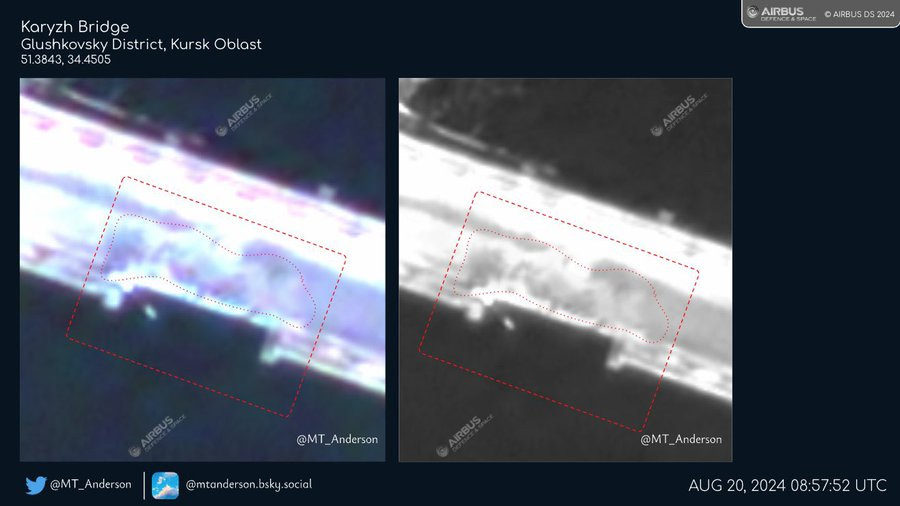
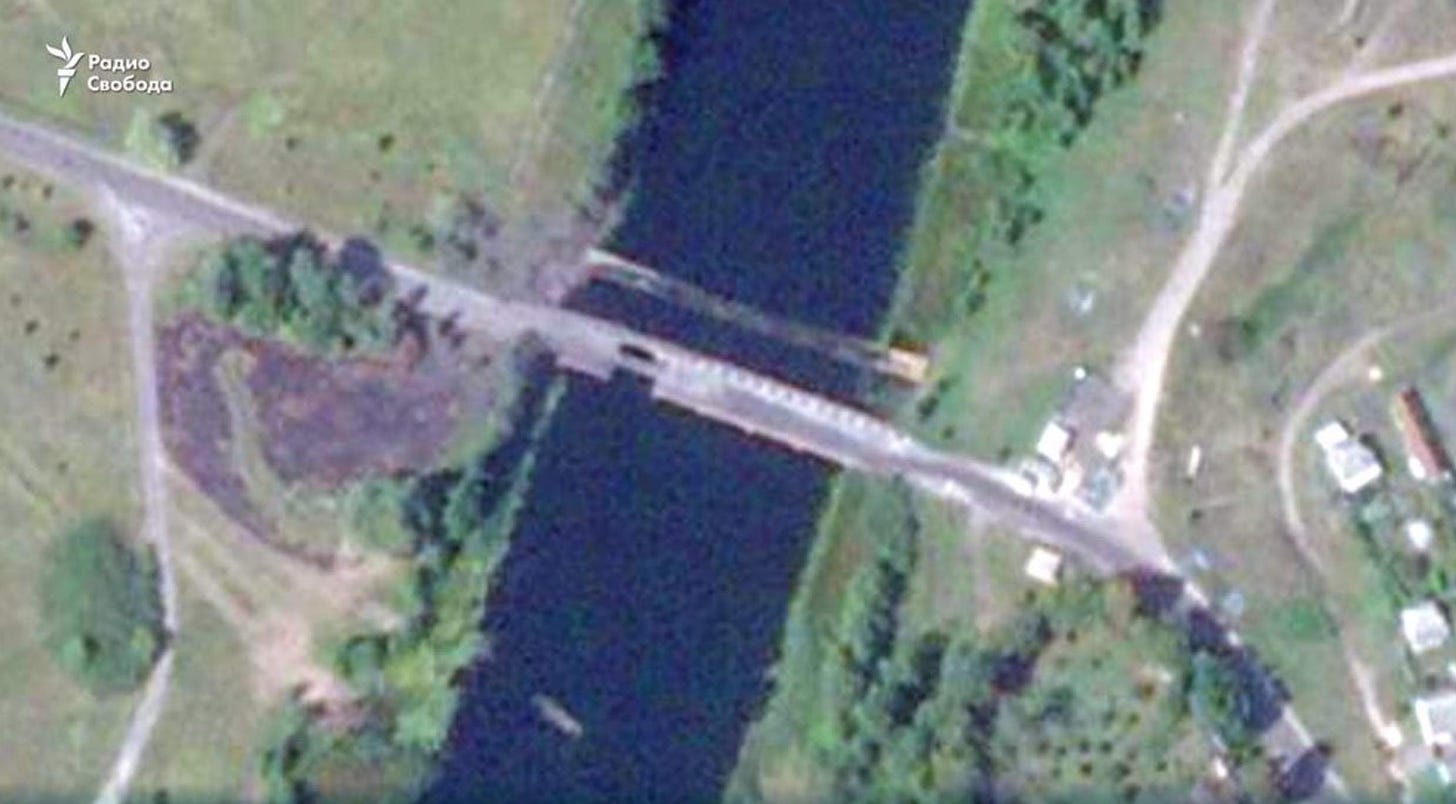
With the three fixed bridges in the Glushkovo sector destroyed or damaged, the Russians are using PMP pontoon bridges to supply their troops. The Ukrainians are constantly looking for them and destroying them when they are found. The resulting situation is so fluid that it is difficult to keep track of all the pontoon crossing sites. Some are reused after a bridge is destroyed. Some are at least partially functional after being sunk in a shallow portion of the river. Here is another destroyed pontoon site.
In this video, vehicles carrying the bridging equipment are attacked before they could be deployed. The site is marked on the map (51.380620536436055, 34.62273319083286). Nearby, there are two different pontoon crossings (and a destroyed vehicle) within 500 meters of each other and also marked on the map. After the one on the right was sunk, the submerged pontoon in the shallow river could still support foot traffic. In this video the surrounding ground is scorched from the attack that sunk that bridge. Of the two vehicles, the drone strikes the one with the EW jammer on the roof. Two Russians run across the sunken bridge on foot.
A view from the ground: In this direction, the “Pontoon Equipment Destroyed” on the map is located less than 500 meters away. In this direction, 3400 meter away is the downed Glushkovo bridge. There’s not a lot of cover or concealment out here.

Kursk- Northern Sector
Because there was a limited number of Ukrainian units and logistical support, there was going to be a limit to Ukraine’s free-ranging exploitation phase after the breakthrough. The exploitation phase was also limited by an increasing number of Russian units that were able to establish some sort of a defense, and there were a number of Russian units that were surrounded at different locations. The surrounded Russian units need to be contained and eventually eliminated by Ukrainian units, which makes them unavailable to expand the perimeter. The isolated Russian units also interfere with Ukrainian supply routes that have to be routed around them.
The Russian 810th brigrade say they suffered “many” casualties 18 km south of the E38.
Kursk- Eastern Sector
There are several surrounded Russian units in this area and a lot of Russian units pushing west to try and break them out. The battle lines aren’t solid, though, as Martynovka was encircled and 19 Russians were able to escape with some being wounded. Russian Spetsnaz units were also able to penetrate the front lines and ambush Ukrainian supply trucks. Ukraine assaulted Malaya Loknya with Marders and infantry and killed or captured all the defenders so they no longer block the supply route to the north.
Lancet strikes on Ukrainian vehicles along with one bombing, plus other destroyed Ukrainian vehicles.
Captured Russian tanks and trucks, including this T-90. Still images (no bodies) of Russian vehicles that were ambushed by the 82nd Brigade near Kruglen’koe and Kalinov.
Ukrainian units in the Donbass are rationing artillery ammo because so much of it is being diverted to Kursk.
Further north, the Russians are spending lots of efforts, equipment, and time to construct a new defence line. The new construction of defensive positions in Kursk consists mostly of trenches and anti-vehicular ditches, which are trenches that are too wide for a vehicle to cross.
A Russian report on the first week of the Kursk offensive in which a local official complains about the confusion, incompetence and lies in Russian leadership at both the federal and local level. For two years the local government fed the conscripts in the region, not the Ministry of Defense. Minefields consisted of warning signs but no mines. Conscripts were sent to the front with two magazines and told to hold out for a day. Ukrainian drones supposedly used drones two months ago for reconnaissance. Ukrainians advanced not on the main road, but on the back roads and trails that were unknown to most locals. Many conscripts were wandering around, abandoned by leaders, and the locals guided them to safety. He said the local leadership shouldn’t receive prison sentences but rather psychiatric treatment.
A confirming source on the false story of a Russian build up near Sumy in order to mask Ukraine’s own build up.
Kharkiv
In Vovchansk, the aggregate plant was bombed by Ukraine but no territory changed hands.
In Hlyboke, not only did the Russians almost push the Ukrainians out of the town, the Ukrainians lost 7 BTR-4’s trying to make it into the village.
Western Luhansk
Russia from of Pishchane and Andriivka but didn’t make any progress.
A portion of the 3rd Assault Brigade was moved to this sector because of the buildup of Russian troops and the intelligence that suggested they would make a push for Borova. Three weeks ago, the brigade conducted a spoiling attack to reduce the number of Russian troops to their front. It was revealed last week that they also conducted an attack 6 km to the south and pushed back the Russians to the Zherebets river, even though they were outnumbered 2.5:1. It should be noted that prior to the attack there was extensive planning and coordination with multiple elements, including tanks, artillery, mortars, aircraft, engineers and scouts. In other words, it was a combined arms operation, with each of those elements increasing the strength of the other elements. The attack relieved pressure on other sectors and reportedly cost the Russians 300 personnel and a fair amount of equipment. Their opposition wasn’t conscripts, either. They were the 237th Tank Regiment and the 24th Spetsnaz Brigade.
When we identify the shortcomings of some units it’s also important to acknowledge the competence of units like the 3rd Assault Brigade that developed the knowledge, discipline and procedures to be an effective fighting force. Because of their success and their publication of their success, their ranks are full of recruits and they have a healthy donor program, all of which contributes to further success. This attack had relatively modest goals of advancing two kilometers until the river was reached, but the thorough preparation and execution allowed them to thoroughly defeat a numerically superior enemy that was among the best the enemy had to offer. This type of operation should be the standard throughout the Ukrainian army.
Siversk
The Russians launched multiple small assaults from the east over several days and lost 4 MT-LB’s and a tank that was damaged. They didn’t gain any territory. Here is a 14 minute video with English subtitles. The narrator explains some details not observed in the video, such as when Russian sappers moved ahead of the assaults to remove mines, how a Russian drone was scouting the assault route, and how smoke obscured the vision of the ATGM crews.
Bakhmut
Sizeable parts of the 11th VDV Brigade, reportedly some elements of the 98th VDV Brigade that used to be deployed in the Bakhmut area, have been transferred to Kursk. Another VSRF brigade is reportedly underway from the Bakhmut area in the same direction.
Arguably, Russia continued to assault across the Siversky Donets - Donbas Canal in small groups but didn’t gain any ground. In one assault, though, they cornered four Ukrainian soldiers and captured them.
A journalist interviewed former prisoners who volunteered to fight. They have the same rights and freedom of movement as other soldiers and the officers and men respect each other. Brigades could send a recruiter to the prison and these men joined the 5th Assault Brigade because they wanted to attack the trenches, and most of them joined together because of their shared experience in the same prison. This unit had already been in close combat. One of them survived a bullet to the chest because of his body armor. The bonds between the members of the unit are strong.
When applying to a brigade, the brigade had to accept them and the the ZSU is only accepting those that are fit and not too old. The 3rd Assault Brigade did not send a recruiter, but then, with their publicized success they have no problems attracting recruits. The 24th Mechanised Brigade is currently preparing another, similarly staffed unit.
Toretsk
The Russians widened their territory between Pivnichne and Toretsk. They also were working on consolidating the territory between Nelipivka and Niu York when the 425th Battalion attacked and cut off the lead Russian elements near Nelipivka.
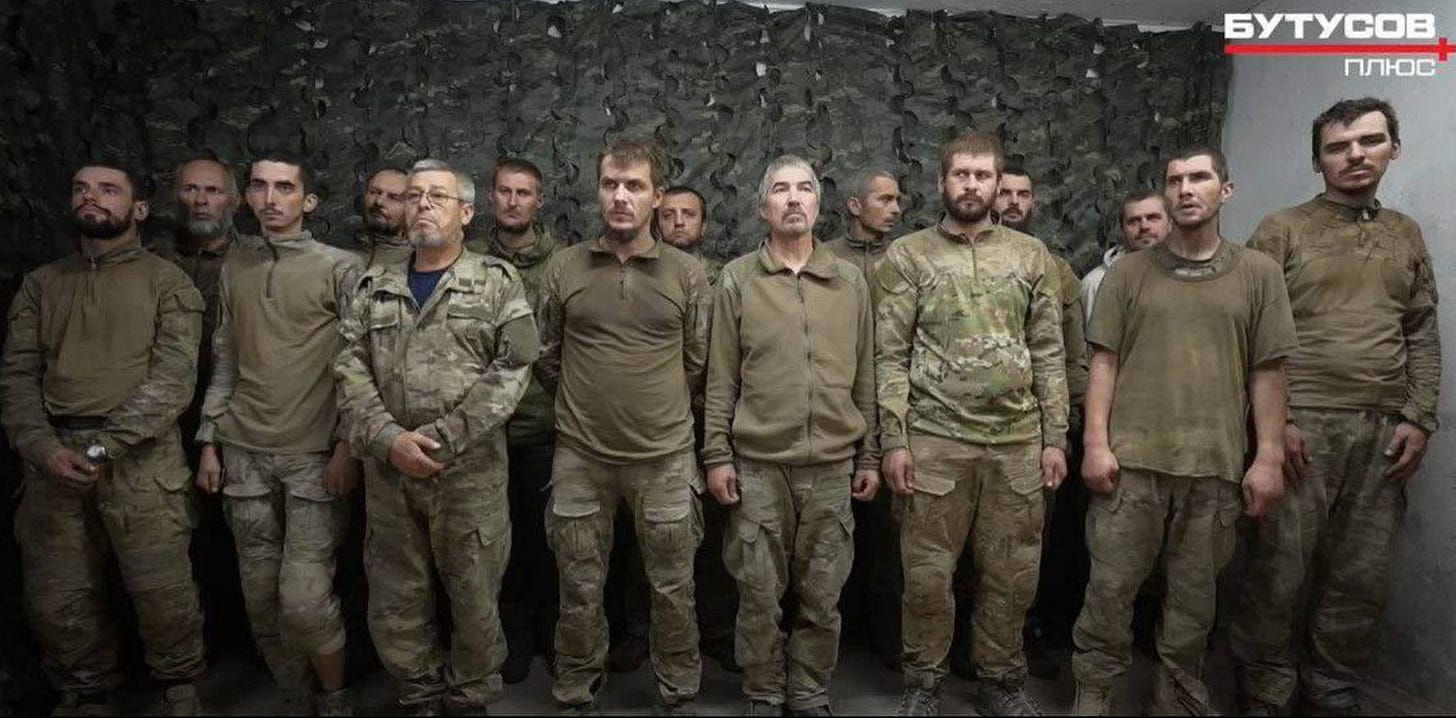
The outcome of that battle is not decided yet. It is a tenuous situation that may not last, but here is a 20 minute video with English subtitles that describes the attack.
A Ukrainian report that says some unnamed unit defending Niu York has leadership that has no idea of the situation, isn’t aware of gaps in the line, expends their resources to gain one position without having anything left and then lie about it in reports to their superiors. According to Militaryland, the 100th and 53rd brigades are closest to Niu York. The 100th was a territorial defense unit that was recently converted to a regular army unit.
The 41st Brigade hunts Russians with drones.
Russians raise a flag in Zavitne.
Pokrovsk-Avdiivka
This remains the area of biggest concern for Ukraine: certainly for its and Western public, probably for the GenStab-U and the ZSU’s Group Tavriya, too. Supported by heavy air strikes, continuous artillery shelling, and relentless UAV-strikes, the approximately 120,000-strong Russian Group Tsentr continues pushing in direction of Pokrovsk in complete disregard of its losses. Multiple ZSU troops serving there are reporting their own surprise at how indifferent to massive losses the Russians became: they shot away one motor-cycle-mounted assault group, and the next is already following; they shot that one away, and the next is already following… and so it goes the entire day… atop of that, they are all the time forced to switch positions because whoever remains in one place for too long, is near-certain to get obliterated - whether by UMPK glide-bombs or by UAVs…
Additionally, the Group Tesntr broadened its front by pushing south against ground that was difficult for Ukraine to hold. This put the ZSU under much pressure, and several battalions had to withdraw in order to avoid encirclement. It must be expected that this week Ukraine will likely withdraw from Yasnobrodivka, too.
On the north-western side of the Russian-occupied salient, the 151st Brigade, the unit we’re supporting by our donations, has held its ground at Hrodivka this week: but, the situation was critical at several points in time and space.
Pokrovsk had a pre-war population of 40,000 people. The city is now in range of the Russian artillery. The government has the ability to evacuate 1,000 people a day but only 5-600 people are leaving each day. In the past, significant numbers of civilians have remained in cities under moderate and heavy bombardment, such as Kherson and Bakhmut. There were still 3,000 people still in Avdiivka when most of the town was in ruins and they were forced to live in basements.
Marinka
There were a few small-scale Russian assaults and they lost about six IFV/APC’s and one artillery piece, but the only gains Russia made was evening up their front after cutting the road by Vodiane last week.
Zaporizhzhia
Ukraine launched a small assault on Staromaiorske in which they lost a tank, but no territory changed hands. Russia did bombard the entire front every day last week with artillery, airstrikes and TOS thermobaric strikes.
Kherson
Russian bombardments and drone strikes continued at an elevated rate and more civilians were killed and wounded.
A Ukrainian MiG-29 drops an AASM bomb on a command bunker in Nova Kakhovka and a Russian-occupied house.
The worst of all is a campaign of terror against the population of Kherson, run by the Russian UAV-operators. After killing and wounding over 100 civilians over the last week - in one day, Russian drone operators killed a policeman and continually attacked those who tried to remove the body from the car. Eleven other civilians were wounded, including an 18-month old baby.
Black Sea
Snake Island isn’t garrisoned but the Russians bombed it probably to destroy some Ukrainian equipment that was being used remotely.
Russia
The System Putin continues to take measures to try and maintain recruitment levels by changing the laws, paying higher signing bonuses and searching for deserters across international borders. Earlier this year Russia raised its conscription age limit from 27 to 30. The Prigozhin rebellion and then the invasion of Kursk unsettled a lot of the Russian population, particularly outside of Moscow and St. Petersburg areas where Russia signs most of their contract soldiers. This has been by design since those two cities have the most domestic political influence, but that may be changing. Signing bonuses have increased to two million rubles in Moscow, which has provided 10% of the soldiers signed in the last year. Signing bonuses increased four times since the beginning of the year as recruiting becomes more difficult. The bonuses represent anywhere from “several times” the local average monthly salary to 68 times the monthly salary in Karachay-Cherkessia. Based on a study of federal spending and calculated bonus payments for the claimed recruitments, Russia recruited 214,000 less people than they have stated since the fall of 2022.
Ukraine’s strategic bombing campaign continues to improve in terms of numbers of drones and missiles and the improved capabilities of these weapons. Continuous strikes on Russian air defenses also played a key part in Ukraine’s success this week, as Tom explained here.
The latest effort in this regards began when reportedly hit an S-300 battery in Novoshakhtinsk, Rostov Oblast.

The 78 or 79 fuel tanks there are part of the Russian federal fuel reserve and holding gas/fuel, oil, kerosene. The site was attacked two times the last week. Over time, the fires spread to adjacent tanks. This is the fire after three days of burning. More than 150 fire engines and over 500 firefighters are on the scene and 50 firefighters have been injured by heat and smoke. After burning for six days, yet more drones attacked the tank farm. This video was taken shortly after the kerosene tanks erupted. Houses in the nearby town caught fire.
In the Volgograd region, 300 km from Ukraine, fire lit up the night and the next day the smoke was thick over the Marinivka air base and there were secondary explosions. Here are the initial satellite images of damage to the base.
There were no initial reports about whether the fourteen Su-25s and fifteen Su-34s recently based there were damaged or not. The light aircraft shelters provided no protection against direct hits and little protection from nearby explosions and fragmentation but did seem to protect aircraft that were further away. In addition to the maintenance facilities, POL dump and ammo dump, Tom reports that 2 Su-34s and an Su-24 were destroyed and the same amount were damaged, and he observed that this is the most successful strike on a Russian airbase to date.
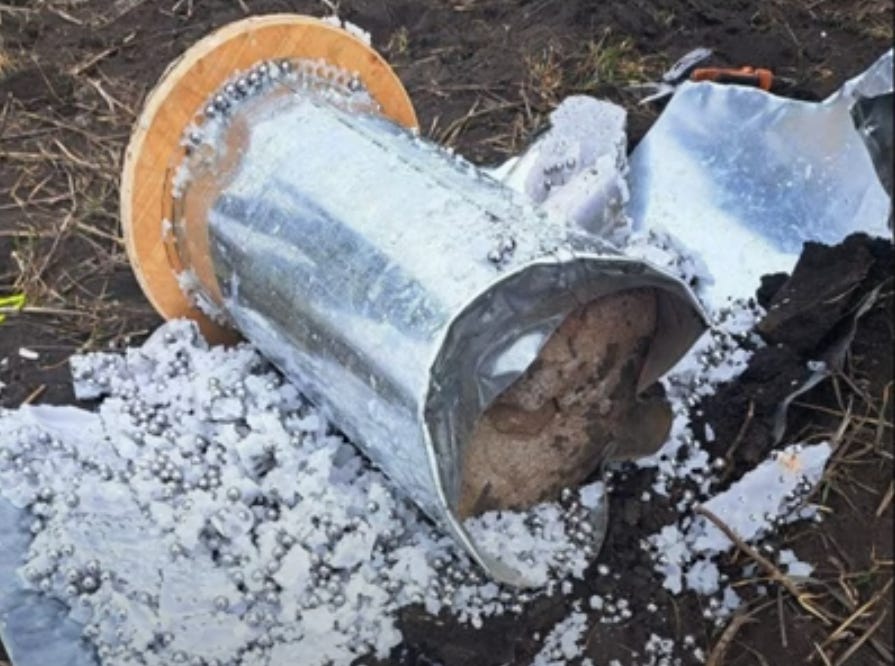
Oktyabrskoye Airfield in Volgograd Oblast was attacked by drones and 12 explosions were reported.
In late July, Olenya air base was attacked 1800 km away from Ukraine and a Tu-22 bomber was hit. It was attacked again last week. Video of a drone being destroyed was posted but there are no other details of the attack.
An ammo dump belonging to the western military group was hit in Ostrogozhsk, 125 km from Ukraine. It reportedly contains 5,000 tons of surface-to-air missiles and other ammunition. Early the next morning, it was still burning with secondary explosions.
Bataysk airbase was hit by drones.
Stefan Korshek details the recent attacks on Russian airfields.
The port of Kavkaz on the Russian side of the Kerch strait was attacked for a third time this month. The Conro Trader, a RoRo ferry that was previously damaged, was loaded with 30 rail cars filled with fuel. It was hit by one R-360 Neptune and set afire. Due to poor fire-fighting equipment and training, it burned out and sunk at a pier. Its wreckage is now blocking one of the two rail ramps. Another RoRo ferry, the Slavyanin was severely damaged on July 23rd and there are no reports on when it might be repaired. The Avangard and Conro Trader were damaged on May 30th and the Conro Trader was subsequently repaired. There are no reports on when the damage to the Avangard might be repaired.
Among other things, Telegram is reported to be used by the Russian military and FSB for planning and operations. The owner of Telegram was arrested in France for his failure to moderate activities on Telegram, his refusal to cooperate with law enforcement, and his lax approach to payment systems, as they pertain to facilitation of paedophilia, drug trafficking, and fraud on his platform.
Ukraine
As more men join the Ukrainian army, jobs that are traditionally held by men, such as mining, are increasingly being held by women. Before 2022, 47% of Ukrainian women worked. After the invasion, 13%, or 1.5 million female workers, left the country. These changes in the workplace may outlast the war.
After Syrsky went to great lengths to maintain secrecy about the planning of the Kursk operation, a member of Ukraine’s parliament said, “The surprises are not over.”
In one of his realtively rare public appearances, Syrsky reported, “Since the beginning of the large-scale aggression, the enemy has used more than 9.6 thousand missiles and almost 14,000 attack drones. Over 2.4 thousand missiles and 9.2 thousand drones were destroyed by air defense systems.”
Ukrainian drone pilots can earn cash for certain targets hit. They can also accumulate points to earn drone equipment for their unit. There’s no word on a points program for the infantry.
Diplomacy
Ukraine and Russia exchanged 115 prisoners, including 82 defenders of Mariupol taken over two years ago.
NATO allies promised to send five more long-ranged air defense systems. Germany sent their PATRIOT system and the US will deliver theirs soon. Romania, Netherlands and Italy won’t be sending a system anytime soon.
If Harris wins the US election, Philip Gordon will likely replace Jake Sullivan as National Security Advisor. For those wondering whether the US will lift restrictions on the weapons it supplies, there is little information to read in the tea leaves.
The president of Belarus congratulated Ukraine on Independence Day. "I am convinced that today's contradictions will not be able to destroy the centuries-old foundation of sincere good-neighborly relations between the peoples of the two countries," Lukashenko said. He also "wished the Ukrainians a peaceful sky, tolerance, courage, strength and success in restoring a decent life."
Speaking of peaceful skies, Iran also congratulated Ukraine on its independence via X/Twitter.
In 2007, Putin’s website celebrated Ukrainian independence from the Soviet Union. "Our peoples are linked by centuries of spiritual and cultural ties and inseparable friendly and neighborly relations," the message read in part, according to the release. "I am convinced that the stability and consistent development that exist today, as well as the progressive strengthening of the Ukrainian government on a sound legal basis, namely that of democratic principles, is in both of our countries' core interests. We are in favor of further developing mutually advantageous Russian-Ukrainian cooperation in all possible ways and expanding joint efforts to make our relations those of truly strategic partners."
Equipment
In Kursk, Ukraine captured an intact anti-drone jammer with documentation in Kursk. The 13 kg device uses magnets to mount on any vehicle and uses 30 watts to jam a wide range of frequencies.
The 100th Mechanized Brigade, the 225th Assault Battalion, the 25th Airborne Brigade, and the 82nd Air Assault Brigade have all been assigned Marder IFVs, and now the 33rd Assault Battalion received Marders, as well.
Some Russian reconnaissance drones appear to be using camouflage, as seen by the Ukrainian drone hunting it. Ukraine is using thermal imaging drones to detect Russian reconnaissance drones flying at night. And another Zala was intercepted by a Ukrainian drone.
In 2015, CIA operatives started working with Ukrainian troops on the front lines and showed them how the Russians were tracking their phones and using their locations to fire artillery missions. This article lists the rules given to Ukrainian soldiers, lists the eight different methods any adversary can use to locate an electronic device, mentions how Russian soldiers sometimes steal phones for communication, not realizing how it puts them at risk, how a German unit in 2019 was reliant on phones because they didn’t have enough secure radios, and says that the Russians use Android malware to locate the tablets that Ukrainians use to steer drones.

These are two Russian FPV drones reportedly using fiber optic cable that is spooled out as it flies. Notice the clarity of the picture and the lack of any kind of interference. One downside is that the drone’s movements cannot be as erratic as a radio-controlled drone as that might break the cable.
The Palyanytsia jet-powered drone was used in Russia for the first time according to Zelensky, hitting an ammo dump in Ostrogozhsk, 125 km away. It can fly 150-300 km depending on the payload of 30-50 kg, and estimates of its speed range from 400-600 kph. The announcement was made during a speech marking Ukraine’s 33rd independence day. The “Palyanytsya” drone missile, named after a traditional Ukrainian bread, carries symbolic and practical significance. The word “palyanytsya” became a linguistic shibboleth during the Russian invasion of Ukraine in 2022, as it is notoriously difficult for non-native speakers, particularly Russians, to pronounce correctly due to the phonetic nuances of the Ukrainian language. The word has since taken on additional cultural resonance, symbolizing Ukrainian identity and resistance.
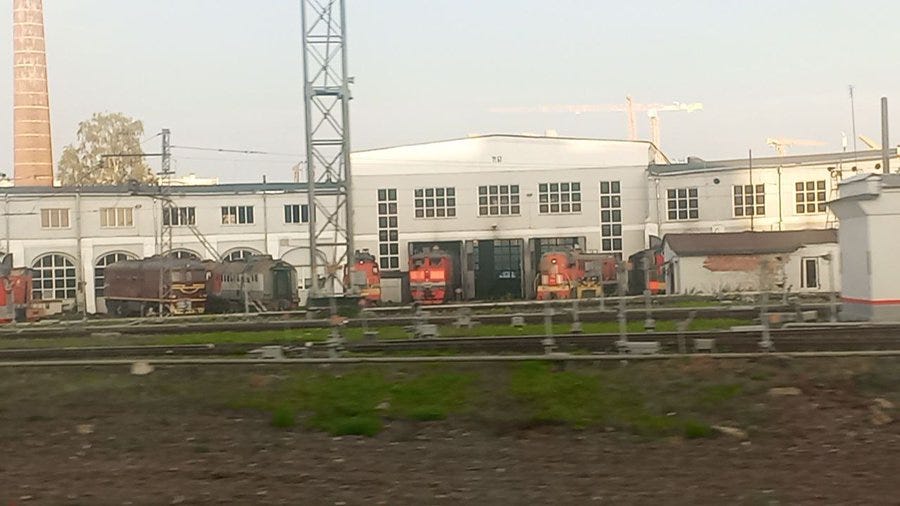
A comparison of self-propelled artillery in a Bryansk storage facility from May 2022, when it held 343 vehicles, to 187 vehicles in August 2024. At the biggest storage site that had half the mothballed self-propelled artillery, the number of vehicles dropped from 2,504 in 2021 to 1,566 now.
Overall, there’s been a 40% decrease in the number of stored self-propelled artillery pieces and many of the remaining vehicles are in too poor of a condition to restore. There’s still 72% of the 2S1 vehicles that were first produced 52 years ago. It’s also taking longer to restore vehicles that are pulled from storage sites, which also speaks to their state of repair. There are too many factors to accurately determine when Russia will virtually run out of self-propelled artillery but the trend continues to show a steady decline in numbers.

Donations to all the Ukrainian units are so important. Constantine bought two excavators that are now working in Kursk. Right now they are focusing on bunkers behind the lines and protective positions for artillery. Constantine is trying to buy this truck which can carry the small excavators and place them on the ground in 5-7 minutes. The small excavators then move into the woods to begin their work while they are concealed by trees. Speed is extremely important in transporting and unloading the excavator because it reduces the window of vulnerability in which a Russian drone can observe them and later direct attacks on the equipment and the men operating it.
